Today I would like to share with you something that I saw when playing a new friend, who is also new to war gaming.
In any game we play we often make mistakes. If you don’t then I imagine you are collectively boring your opponent, taking too long on your turn, and obsessive in an unhealthy way.
I may be wrong.
I often am, but since its my blog, I can say that.
So lets assume the rest of us weee bit normal folks who play with little bits of cardboard for hours on end and make noise like ‘bink” , “pong”, “BOOM” ….ahem….anyway lets ignore the normal bit….work with me here.
So we are all playing a game, nice fast playing tactical situation, that is evenly balanced.
In every game there is that moment.
That dreaded second when you sigh inwardly, clench your butt, or feel a drop of sweat fall onto your hip, or man boob (which ever gravity slams it into) as you realize in an instant “I just lost the game”.
For some that is crushing, for others a challenge, then again different folks may not even realize they have lost OR won!
The feeling passes quickly enough. If we could rewind the clock we might have chosen a different path.
Its seems sometimes to fall away with a sense of false bravado you think to yourself “Maybe he did not notice” or “it will be ok I have a 1/12 chance of survival, the dice are rolling my way tonight”…. You know what I mean right!
When on the inside you are screaming at yourself for being a complete idiot!
So here is a game I played recently. Let us see how many Turning Points pop up in one 5 turn game of Heroes of the Gap. I am sure most of you know the game, its squad based tactical action set in WWIII. The same system as the Band of Heroes set in WWII and several other titles from Lock’ n Load Publishing. Its roots harken back to ASL, and I think (no one else does) Team Yankee.
If you understand the 3F’s : Find Them /Fix Them / Finish Them mentality you can play this game. So shall we take a look and see what the alternatives might have been!
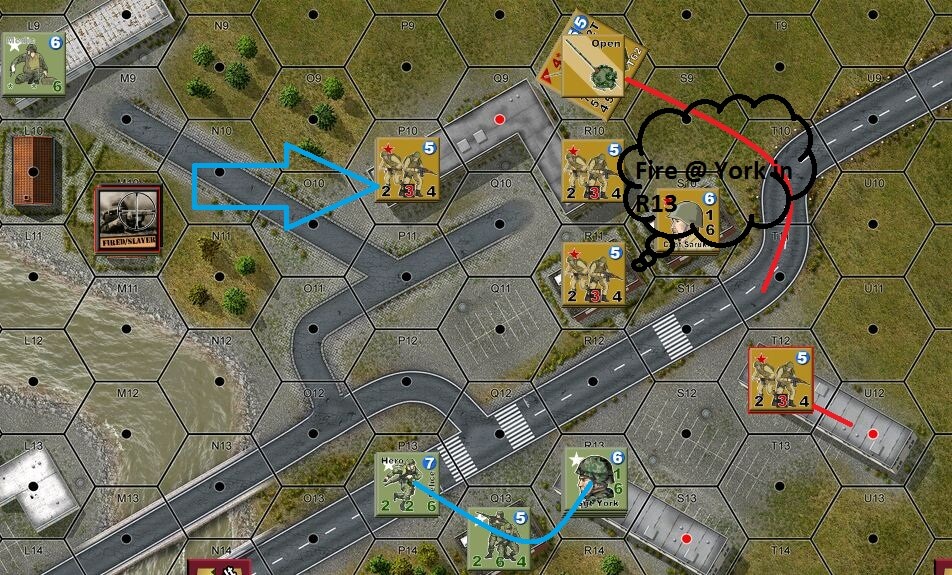
From the get go the Soviets elected not to shoot at the lone unit in the street ( a scenario starter story bit) who was worth 2VPs to the USA alive, or 1 if dead to the Soviets. The Victory conditions mandate the capture of the enemy city building hexes.
Instead the Soviets focus on finding (i.e. spotting) the Yanks. Good idea as this will keep their units hidden until the US try and spot them.
During the alternating impulses the Hero unit makes it to the cover of a building. The Soviet does not want to expose his units to fire again so he waits. Finally he spots and all hell breaks loose with fire exchanged on all sides. The Units North of town do not fire however.
Whilst otherwise engaged the US close assaults the lone stack of 2 soviet squads. A somewhat bold move, but at 2:1 the US player thinks its a good gambit, and is not exposed to any potential Opportunity fires.
Disaster strikes and the first tactical Turning Point is reached!
The US player wins his fight against one squad, the return combat (melee is simultaneous in LNL) is at 1:1 and the Soviets win. The US squad, with special skill, and Leader are dead. To add insult to injury the the Soviets take the M60.
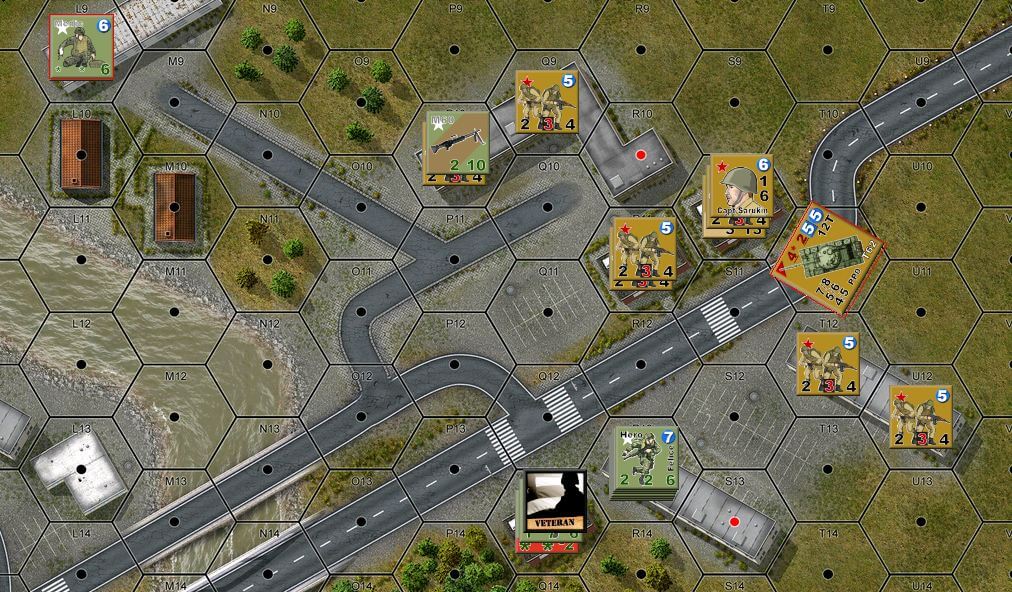
No doubt the US player realizes the error too late. The gut tightens the mouse is clenched tightly and he/she exhales long and slow……
What were the alternate choices?
1. Do nothing, and await the expected Tank assault
2. Do nothing and await Opportunity fire next turn.
3. Close assault the lone units adjacent to the pair of squads
4.Move into the empty building hex in the L shaped building
The US now has 3 exposed building hexes, and one squad and a medic (who can rally) to protect them.
Immediately after clicking done the US player knows he has made a fatal error.
Lets look real quickly at what the options for the Soviet player could be:
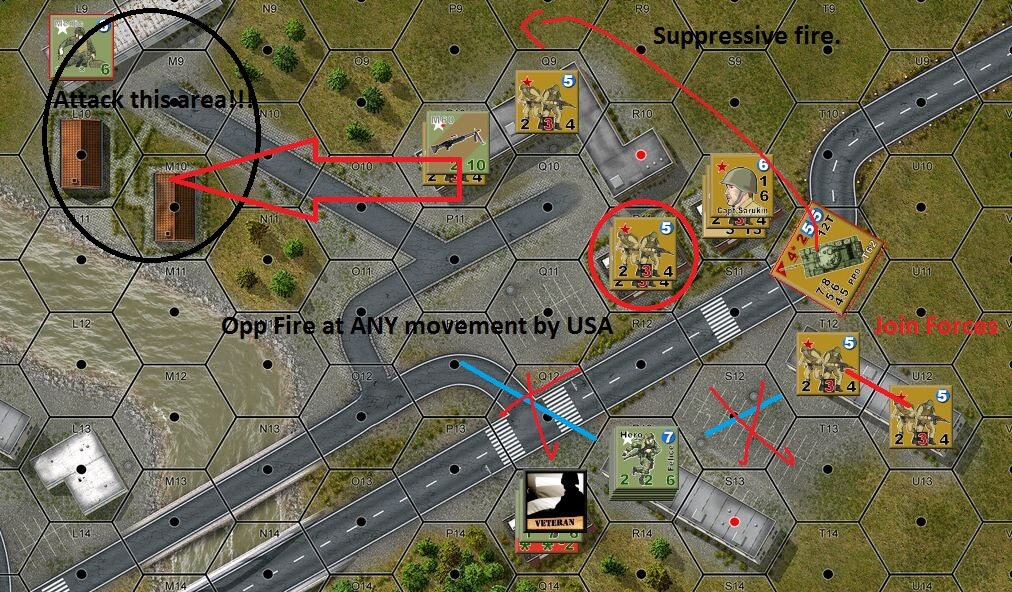
This approach of moving the forces North and trying to pin the Southern teams under York is a viable plan.
The Soviet player needs to be very carefully however as the US player has a Hero with a LAW and a 2nd Hero who could be used as bait.
But the fact remains that is in turn 2 the Soviets either :
1. Sit tight and Opportunity fire, waiting for the US player to make a move
2. Push North either way yields good results.
3. The 3rd plan and most risk is continuing to swap shots and attack South.
This is fraught with risk due to the fact that the Soviets are spread out in 3 different locations, and combined fire is a challenge. Attempting to draw fire or trade shots exposes squads to risk. Under the3F doctrine we have found them. We know where they can go (blue lines) and we can cover both avenues with fire. They are fixed in place.
Meanwhile in the North the lone US squad will likely not move as he wants to :
1. avoid being shot at
2. avoid being shot at and
3. not miss anchance to Opportunity Fire.
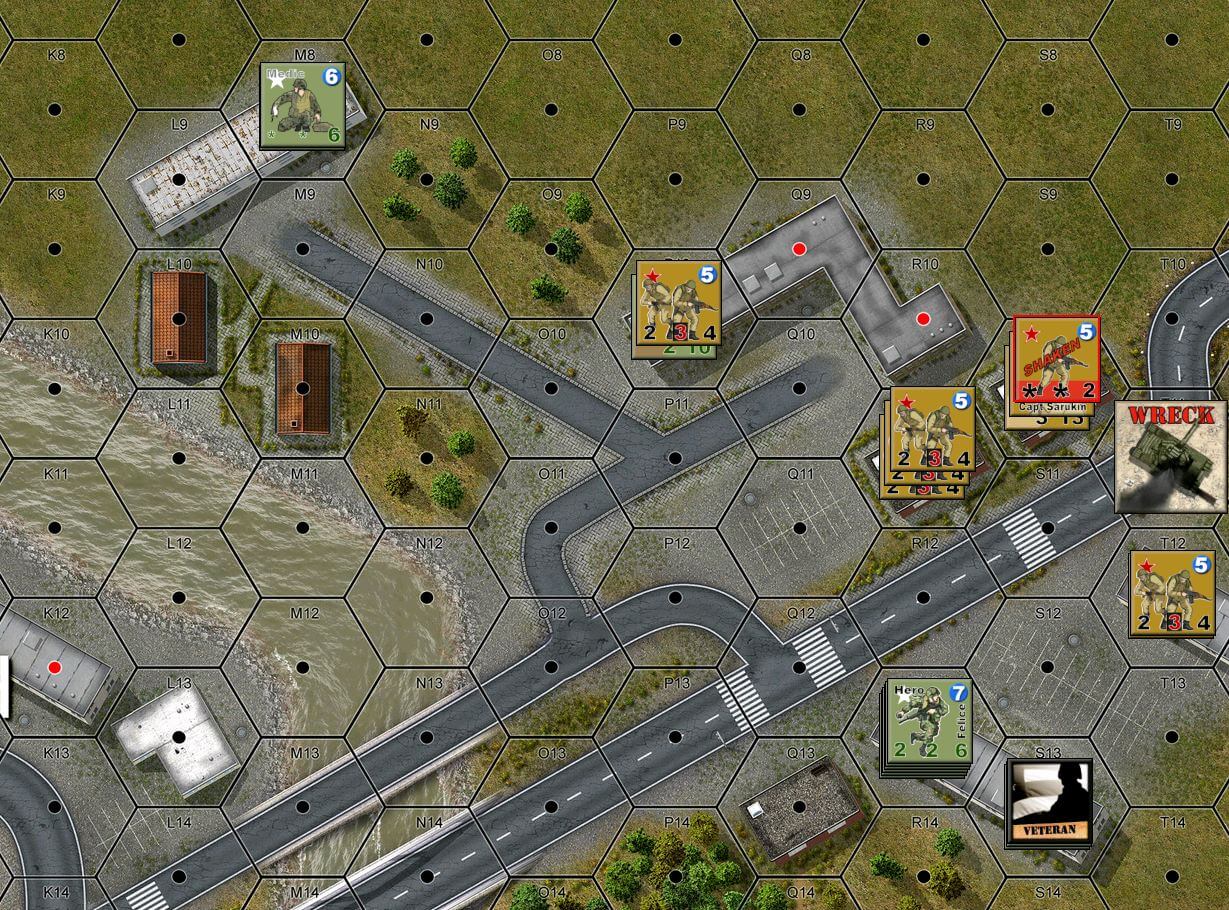
The US player takes initiative in Turn 2.
His first action is to attempt to eliminate the largest threat. Luckily this works out. However even with out the tank the Soviets are still in good shape. They consolidate forces and appear to be preparing to assault.
The loss of the Tank is however Turning Point 2.
The Soviet player now realizes that they should have examined fields of fire prior to movement, assessed the chances of the LAW hitting (7 or less on 2d6 no drms) and perhaps moved that tank not so far South. The balance has evened up a little now and the game can go either way.
Turn three provides some further surprises for both sides.
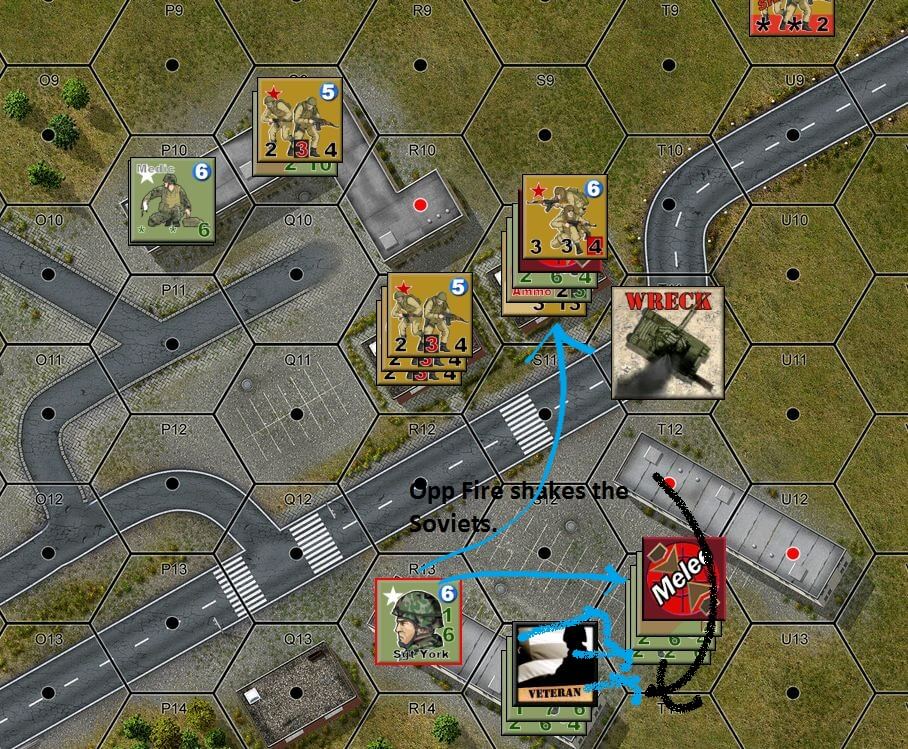
Opportunity fire is executed against advancing units in the open. 2 squads were sent forward to draw fire. Turning Point 3!
The Soviet player could have achieved this with one Squad. We can imagine as the US player calls out “Opportunity Fire +2 for adjacent+1 for movement….etc” that a sinking feeling occurs.
Now 2 squads are trapped in the open shaken with low likelihood of surviving the turn. To make matters worse the Squads firing at each other last turn did not all recover from suppression/shaken results.
So the Soviets now have 3 squads shaken and a leader alone in a hex with no weapon.
What were the options?
1. Wait
2. Move a unit to support the leader
3. Wait and recover that 1 squad and leave the 2 squads in the South to fight the US, whilst heading North.
Turning Point 4. The US send a squad and a hero into the now shaken units in the road after the Soviet primary stack of 3 units fires. This allows the area to be open for movement sans opp fire (note turns are two to 5 minutes). The Soviets are eliminated.
He then sends the second squad up the road to attack the suppressed Soviet squad with the sole Soviet Leader. All Soviet units are eliminated.
Why is this a turning point? Well the US have left an ops complete Leader alone. IF the Soviets take initiative the US loses its leader. A really big deal. Even with the Soviet leader gone, that leaves only the US hero counters and medic able to rally.
1. The US player could have:
2. Sent a low risk Hero unit to Melee/Close Assault and finish of the shaken units.
3. He then could have marched one unit into the T12 building for another VP.
Or vice Versa using the Hero and taking both hexes of the T12 building.
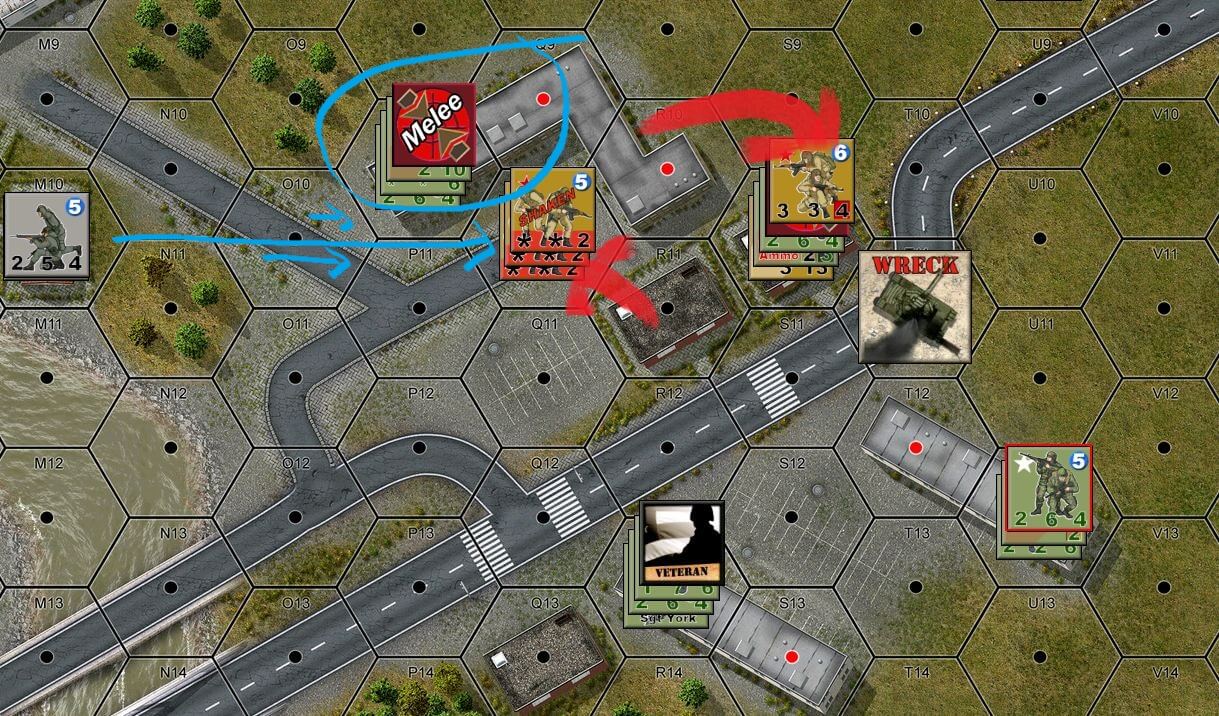
Random events from captured hexes, bring a Soviet unit on board and then a US one for building hexes captured by the US.
Turning Point 5. The Soviet Player and the US player have open choices where to place units. The Soviet receives his unit first. The entire mapboard North is open. He can place the unit in ANY building hex. The Soviet in an aggressive mode bring sit on close to the recent melee and attacks the squad there. This attack fails.
Any other hex chosen with that activation in the North of the map could have secured 2 VPS. The US player is then close assaulted by the solo squad and survives.
The US then receives his unit for the random event. He places it defensively.
This cements the US victory?
Why?
Well by placing the Territoralheer in a slot to Opp fire to cover all the buildings in the North the Soviet player is locked down, with a low percentage chance of avoiding suppression in the open, and no leader to aid recovery. Other locations would have been effective. But under the doctrine of Find, Fix, Finish the West German unit could cover access to VP hexes and support his team mates.
The Soviets attempt to re capture their soon to be lost hex and are suppressed in the open.
Even in an apparently one sided battle the tides of war fluctuate. Our job as players is to make the most of the situation we find ourselves in.
Early in this game it was very clearly going to be lights out for the US, only to see them kncukle down and let terrain, and the offense of the enemy work for him. The US player faced a rout.
He broke the rules of fixing the enemy and rushed to finish.
After the early setback the US player knew he had 2 VPS in the bag, he just had to hang on and hope for an opening or two to capture one or more building hexes.
He waited, watched and carefully fixed and finished enemy units in low risk attacks in 3 out of the 4 close assaults, and each fire action was either overwhelming or against units in open terrain.
The Soviet player had an opportunity to wrap the game up early but was too focused on the finishing aspect of the engagement versus fixing first then either eliminating or neutralizing the threats he faced.
He failed to see the victory opportunity.
Which brings up a point. The whole focus of the 3F’s are only valuable in the context of the objective. The US player became caught up in the VP hex chase, without realizing he risked the entire battle with one melee!
The Soviet player was fixated on combat in close quarters and ‘engagement’ versus selective targeting.
Modern combat in particular pays dividends when the combatants are discrete with fire, and target selection.
It is important for us to recognize and expect the Turning Points, both good and bad and manage to them.
Sometimes the Turning Point is upon you before you know it.
Related articles
- Tactics in Modern Combat. (meshtime.com)
- First Contact. (meshtime.com)
- Team Yankee (meshtime.com)

2 thoughts on “Tactical Turning Points”
Comments are closed.